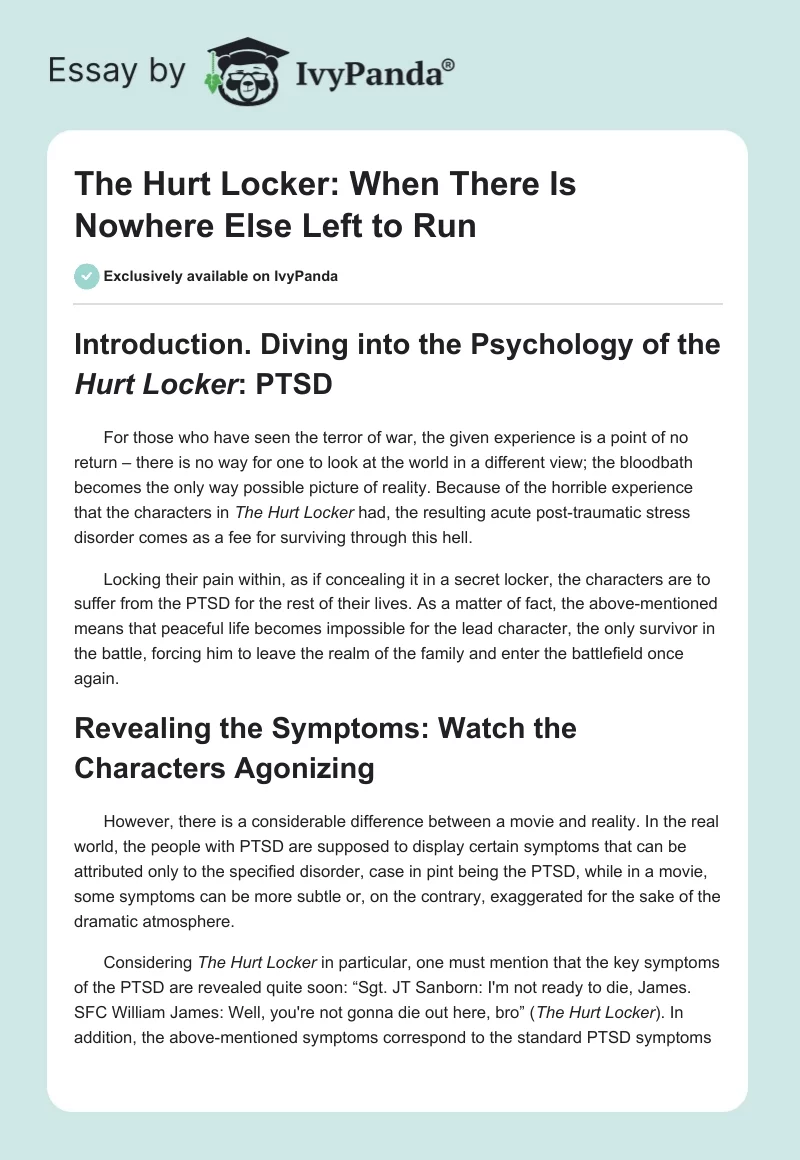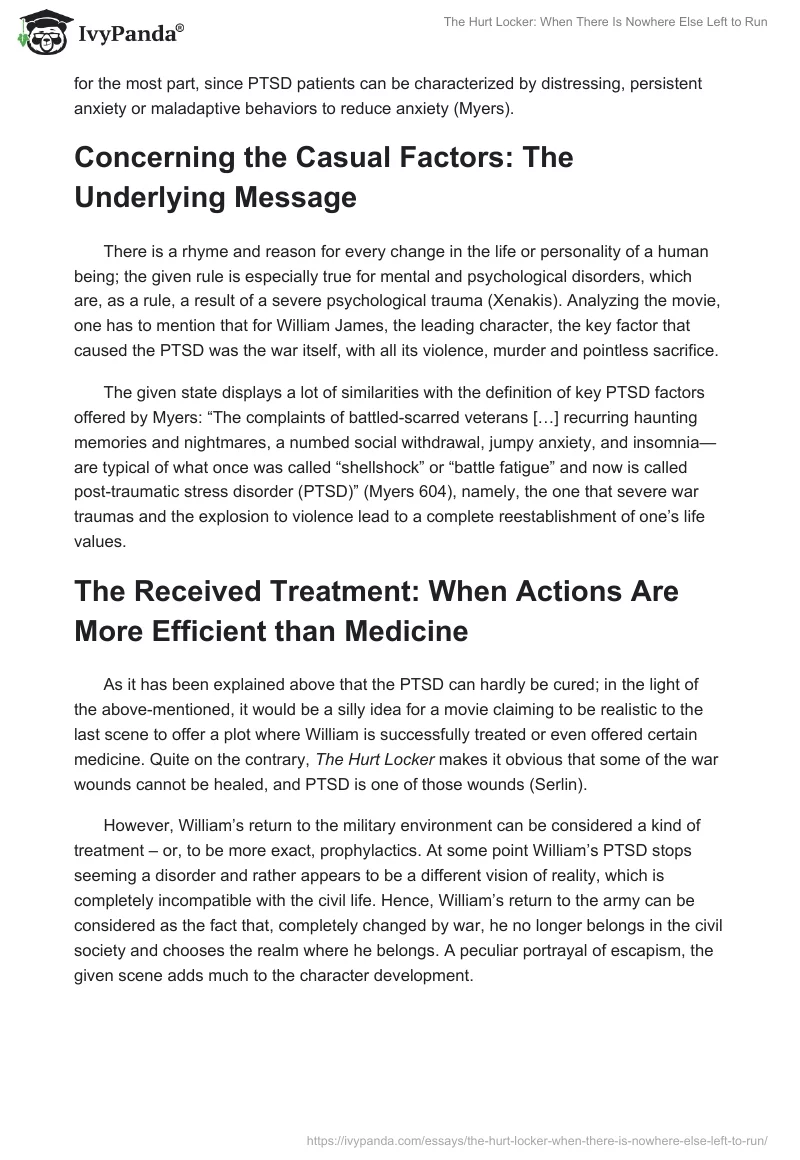- Introduction. Diving into the Psychology of the Hurt Locker: PTSD
- Revealing the Symptoms: Watch the Characters Agonizing
- Concerning the Casual Factors: The Underlying Message
- The Received Treatment: When Actions Are More Efficient than Medicine
- PTSD and the Characters’ Personal Life: Concerning the Impact
- Walking in the Characters’ Shoes: Life with PTSD
- Overall Reaction and the Portrayal of the PTSD Disorder
- Works Cited
Introduction. Diving into the Psychology of the Hurt Locker: PTSD
For those who have seen the terror of war, the given experience is a point of no return – there is no way for one to look at the world in a different view; the bloodbath becomes the only way possible picture of reality. Because of the horrible experience that the characters in The Hurt Locker had, the resulting acute post-traumatic stress disorder comes as a fee for surviving through this hell.
Locking their pain within, as if concealing it in a secret locker, the characters are to suffer from the PTSD for the rest of their lives. As a matter of fact, the above-mentioned means that peaceful life becomes impossible for the lead character, the only survivor in the battle, forcing him to leave the realm of the family and enter the battlefield once again.
Revealing the Symptoms: Watch the Characters Agonizing
However, there is a considerable difference between a movie and reality. In the real world, the people with PTSD are supposed to display certain symptoms that can be attributed only to the specified disorder, case in pint being the PTSD, while in a movie, some symptoms can be more subtle or, on the contrary, exaggerated for the sake of the dramatic atmosphere.
Considering The Hurt Locker in particular, one must mention that the key symptoms of the PTSD are revealed quite soon: “Sgt. JT Sanborn: I’m not ready to die, James. SFC William James: Well, you’re not gonna die out here, bro” (The Hurt Locker). In addition, the above-mentioned symptoms correspond to the standard PTSD symptoms for the most part, since PTSD patients can be characterized by distressing, persistent anxiety or maladaptive behaviors to reduce anxiety (Myers).
Concerning the Casual Factors: The Underlying Message
There is a rhyme and reason for every change in the life or personality of a human being; the given rule is especially true for mental and psychological disorders, which are, as a rule, a result of a severe psychological trauma (Xenakis). Analyzing the movie, one has to mention that for William James, the leading character, the key factor that caused the PTSD was the war itself, with all its violence, murder and pointless sacrifice.
The given state displays a lot of similarities with the definition of key PTSD factors offered by Myers: “The complaints of battled-scarred veterans […] recurring haunting memories and nightmares, a numbed social withdrawal, jumpy anxiety, and insomnia—are typical of what once was called “shellshock” or “battle fatigue” and now is called post-traumatic stress disorder (PTSD)” (Myers 604), namely, the one that severe war traumas and the explosion to violence lead to a complete reestablishment of one’s life values.
The Received Treatment: When Actions Are More Efficient than Medicine
As it has been explained above that the PTSD can hardly be cured; in the light of the above-mentioned, it would be a silly idea for a movie claiming to be realistic to the last scene to offer a plot where William is successfully treated or even offered certain medicine. Quite on the contrary, The Hurt Locker makes it obvious that some of the war wounds cannot be healed, and PTSD is one of those wounds (Serlin).
However, William’s return to the military environment can be considered a kind of treatment – or, to be more exact, prophylactics. At some point William’s PTSD stops seeming a disorder and rather appears to be a different vision of reality, which is completely incompatible with the civil life. Hence, William’s return to the army can be considered as the fact that, completely changed by war, he no longer belongs in the civil society and chooses the realm where he belongs. A peculiar portrayal of escapism, the given scene adds much to the character development.
PTSD and the Characters’ Personal Life: Concerning the Impact
Because of the awful slaughter which William saw in the battlefield, he is not able to live among the rest of the people anymore. He even cannot look at his son playing carelessly without a bitter remark: “And then you forget the few things you really love. And by the time you get to my age, maybe it’s only one or two things. With me, I think it’s one.” (The Hurt Locker). William no longer can live in civil society.
Walking in the Characters’ Shoes: Life with PTSD
It seems that living with this kind of a mental disorder is much like feeing completely out of place all the time. As a matter of fact, William must have felt like a living dead waking among the living ones, since he could not share their emotions; neither could he be happy just for a while – constantly on alert for something bad to happen, he felt that peaceful life is no longer his realm.
Overall Reaction and the Portrayal of the PTSD Disorder
Hence, it can be considered that the idea of the PTSD disorder developing within the minds of the people who have faced the dread of war has been portrayed in the movie in a rather impressive way.
Making the audience go through all the tortures that the lead character faces, the movie creates a very authentic atmosphere, portraying the people whose idea of reality has been replaced with the war strategy and the heat of the fight. It is important that the actors play their roles in a rather subtle way, which makes the impression even greater, and the images of the people suffering from PTSD even more memorable.
Works Cited
Hurt Locker. Ex. Prod. Tony Mark. Universal City, California: Universal Studios. 2012. DVD.
Myers, David G. Psychology. 9th ed. New York, NY: Worth Publishers. 2010. Print.
Serlin, Irene. “Hurt Locker: Treating Trauma in the Body and the PTSD Experience.” Psychology Today. 2010. Web.
Xenakis, Stephen n. d. What “The Hurt Locker” Got Right. Web.


